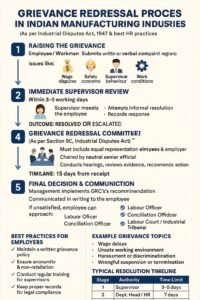How to Handle Grievance Redressal in Indian Manufacturing Setups: Insights from the Industrial Disputes Act, 1947.

Introduction: The Pulse of Manufacturing Harmony
Imagine a factory floor where a single worker’s complaint about unpaid wages sparks a strike, shutting down production. I’ve seen it happen, and it’s a stark reminder of how vital grievance redressal is in Indian manufacturing setups. From textile mills in Coimbatore to steel plants in Bhilai, unresolved issues can cripple operations. The Industrial Disputes Act, 1947 (ID Act), offers a legal framework to address disputes fairly. This blog dives into how to handle grievance redressal in Indian manufacturing setups, exploring union roles, HR/IR responsibilities, the impact of unaddressed grievances, and strategies to ensure harmony. Let’s create a workplace where trust fuels productivity.
Understanding Grievance Redressal in Indian Manufacturing Setups
Why is grievance redressal so critical in Indian manufacturing? It’s the mix of diverse workers, union dynamics, and high-stakes production schedules. Grievances—wage delays, unsafe conditions, or unfair dismissals—can halt assembly lines if ignored.
The ID Act 1947 Framework
The ID Act defines a grievance as any dispute over employment terms. Section 9C mandates factories with 20+ workers to form a Grievance Redressal Committee (GRC). A 2023 Deloitte India report notes 62% of manufacturing workers fear retaliation when raising issues, underscoring the need for robust systems.
Types of Grievances
Wage Disputes: Unequal or delayed payments.
Work Conditions: Unsafe machinery or excessive shifts.
Disciplinary Issues: Biased appraisals or terminations.
Role of Works Committee in Grievance Redressal
Works Committees, required under Section 3 of the ID Act for factories with 100+ workers, foster collaboration between management and workers to prevent collective grievances.
Key Responsibilities
Preempt Disputes: Discuss safety, hours, or policies to address concerns early.
Facilitate Dialogue: Resolve group issues, like shift changes, before escalation.
Advise Management: Suggest worker-friendly solutions to maintain harmony.
Case Study: Textile Mill in Coimbatore (2019)
Issue: Workers opposed a new shift schedule disrupting work-life balance. Solution: The Works Committee, with union and management reps, proposed flexible shifts after consultations. Management adopted the plan. Outcome: A strike was averted, and productivity stabilized, per a 2020 Business Standard report.
Reference: Business Standard, 2020
Precaution: Ensure balanced representation to avoid bias. Monthly meetings keep issues in check.
Role of Unions in Grievance Redressal
Unions are pivotal in Indian manufacturing, amplifying worker voices and ensuring fair redressal under the ID Act. They can escalate or resolve disputes, depending on their engagement.
Key Responsibilities
Advocacy: Represent workers in GRC hearings, especially for wage or termination disputes.
Negotiation: Bargain with management for collective agreements, like better safety measures.
Mobilization: Rally workers to raise legitimate concerns, ensuring visibility.
Case Study: Auto Parts Factory in Pune (2021)
Issue: Workers faced delayed overtime payments, leading to union-led protests. Solution: The union, under ID Act’s conciliation process, negotiated with HR, securing back pay and a transparent payment system. Outcome: Trust improved, and production resumed, per a 2022 Economic Times report.
Reference: Economic Times, 2022
Precaution: Avoid confrontational union tactics by fostering regular dialogue. HR should meet union leaders monthly.
HR and IR’s Focused Role in Grievance Redressal
HR and Industrial Relations (IR) professionals are the linchpins of grievance redressal, blending empathy with ID Act compliance to keep factories running smoothly.
HR’s Role
Policy Architects: Develop clear, ID Act-aligned grievance policies.
First Responders: Acknowledge complaints within 48 hours, building trust.
Investigators: Conduct impartial inquiries, documenting per Section 9C.
Trainers: Equip supervisors with conflict resolution skills.
IR’s Role
Union Mediators: Negotiate with unions on collective disputes, like wage hikes.
GRC Facilitators: Ensure fair hearings, balancing worker and management views.
Compliance Guardians: Align processes with ID Act and Factories Act.
Precautions
Curb Bias: A 2022 SHRM India study found 55% of grievances fail due to perceived favoritism.
Safeguard Anonymity: Use secure channels for sensitive issues.
Act Swiftly: Delays breach Section 9C’s 45-day rule.
Example: In a Chennai factory, HR’s slow response to a safety grievance fueled union unrest. IR’s quick mediation averted a shutdown.
Crafting a Grievance Redressal Policy Under ID Act 1947
A robust policy, per Section 9C, ensures timely dispute resolution in manufacturing setups.
Policy Essentials
Accessibility: Translate into languages like Hindi or Kannada; display on notice boards.
Confidentiality: Protect whistleblowers, especially in harassment cases.
Timelines: Acknowledge complaints in 48 hours; resolve in 30 days.
GRC Structure: Equal worker-management reps.
Legal Compliance
Align with the Factories Act, 1948, for safety grievances, and the Sexual Harassment Act, 2013, for ICC mandates. Annual audits keep policies compliant.
Pro Tip: Involve unions in policy reviews for buy-in.
Step-by-Step Guide to Handle Grievance Redressal
A structured process, rooted in the ID Act, resolves grievances effectively.
Step 1: Receive and Acknowledge
Accept complaints via HR, unions, or digital forms. Respond within 48 hours.
Step 2: Investigate Neutrally
Collect statements from all parties.
Use a neutral GRC member to avoid bias.
Document per ID Act standards.
Step 3: Resolve Collaboratively
Hold GRC hearings within 45 days. For a wage dispute, review payroll and involve unions.
Step 4: Follow Up
Check in after 30 days to prevent retaliation.
Challenge: Union pressure can complicate fairness. IR’s mediation is crucial.
Call to Action: Document a grievance process this week. Share your insights in the comments!
Impact of Unaddressed Grievances on Production
Unresolved grievances in manufacturing setups don’t just hurt morale—they hit the bottom line. A 2023 PwC India study found that 70% of production delays in Indian factories stem from labor disputes.
Key Impacts
Production Halts: Strikes or slowdowns, like a 2018 Gujarat factory shutdown over unpaid wages, cut output by 40% for a month.
Low Morale: Disengaged workers reduce efficiency, increasing defects.
High Turnover: Unresolved issues drive skilled workers away, raising hiring costs.
Reputation Damage: Publicized disputes deter talent and clients.
Case Study: Steel Plant in Durgapur (2020)
Issue: Unaddressed safety grievances led to a worker walkout. Outcome: Production dropped 25% for two weeks, costing millions, per a 2021 Hindu Business Line report.
Reference: Hindu Business Line, 2021
Precaution: Address grievances promptly to avoid escalation. Regular Works Committee meetings help.
Also Read: How Strategic Employee Engagement Initiatives Boost Workplace Productivity and Retention.
Role of Labour Department in Resolving Disputes
The Labour Department steps in when internal redressal fails, acting as a neutral arbiter under the ID Act.
Key Functions
Conciliation (Section 12): Officers mediate disputes, like wage conflicts, to prevent strikes.
Adjudication (Section 10): Refer unresolved cases to Labour Courts or Tribunals.
Compliance Checks: Inspect factories for ID Act adherence.
Case Study: Rubber Factory in Kerala (2018)
Issue: A termination dispute escalated to the Labour Department. Solution: A conciliation officer, per Section 12, mediated, reinstating the worker with back pay. Outcome: Dispute resolved without litigation, per a 2019 Business Standard report.
Reference: Business Standard, 2019
Precaution: Provide detailed GRC records to aid Labour Department conciliation.
Common Grievances in Indian Manufacturing set ups
Grievance Type | Description | Prevalence | Resolution Strategy |
|---|---|---|---|
Wage Disputes | Delayed or unequal pay | 35% | HR audits, union mediation |
Work Conditions | Unsafe equipment, long shifts | 30% | Works Committee input, safety upgrades |
Disciplinary Issues | Unfair terminations, biased appraisals | 25% | GRC hearings, clear policies |
Union Conflicts | Contract labor disputes, union rights | 10% | Labour Department conciliation, IR talks |
Note: Prevalence data from Deloitte India (2023).
Conclusion: Strategies for Lasting Harmony in Manufacturing
Grievance redressal in Indian manufacturing setups is more than a legal obligation—it’s a commitment to fairness and trust. Unaddressed grievances, as seen in Durgapur’s steel plant, can cripple production, morale, and reputation. The ID Act 1947, through Works Committees, GRCs, unions, and the Labour Department, provides a robust framework. HR and IR’s empathetic, compliant approach ensures disputes don’t derail operations. Cases like Coimbatore’s textile mill and Kerala’s rubber factory show the power of proactive redressal.
Strategies for Success
Strengthen GRCs: Train members on ID Act provisions and mediation.
Engage Unions Proactively: Hold monthly dialogues to preempt disputes.
Empower Works Committees: Use them to address collective concerns early.
Leverage Labour Department: Seek conciliation for complex cases.
Monitor Impact: Track production metrics to gauge redressal effectiveness.
These steps aren’t just about resolving complaints—they’re about building a culture where workers feel valued, boosting productivity and loyalty. What’s one strategy you’ll implement to improve redressal in your factory? Share your thoughts in the comments or pass this post to a colleague who could use these insights. Let’s create manufacturing setups where harmony drives success.
Acknowledgments
This blog draws on:
Deloitte India (2023) for worker hesitation stats.
PwC India (2023) for production delay data.
SHRM India (2022) for grievance bias insights.
Business Standard (2019, 2020) for Coimbatore and Kerala cases.
Economic Times (2022) for Pune case.
Hindu Business Line (2021) for Durgapur case.
Industrial Disputes Act, 1947, Sections 3, 9C, 10, 12.
Factories Act, 1948, for safety guidelines.
